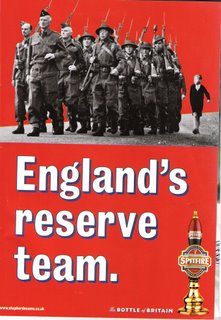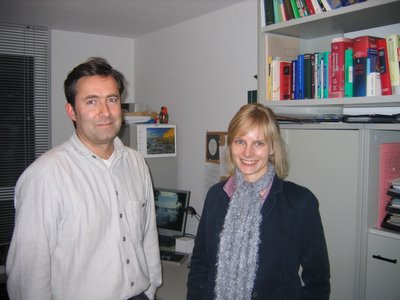
Don't panic! Don't panic! Unless you're a creative who's run out of steam...
In 1968, David Ogilvy wrote a letter that was distributed at New York's Grand Central Station to help raise money for an African-American college fund. The opening line asked readers to look out of the train window when they reached 108th Street. Seeing with their own eyes the homes of the impoverished black students, they donated $26,000 in one evening. A simple idea that proved incredibly powerful. And an inspiration for this blog on advertising creativity around the world.
 More power to you: 4-wd dm letta from BT is lol
More power to you: 4-wd dm letta from BT is lol Breaking the language barrier: Alex Woodruff and Vanessa Cisz in englishtalk's Stuttgart offices.
Breaking the language barrier: Alex Woodruff and Vanessa Cisz in englishtalk's Stuttgart offices.
Interesting discussions in the land of wild boar
What separates true entrepreneurs from the wannabes? I suspect it’s an uncanny ability to spot an opportunity or niche in the market and act quickly to fill it. That’s exactly what marketing consultant Alex Woodruff did when he founded englishtalk (www.englishtalk.net) – a business that assists German advertising agencies and corporations to promote products and services more effectively in the UK, US and other English-speaking countries around the world.
I travelled to Southern Germany recently to meet Alex and his colleague Vanessa Cisz, who oversee the englishtalk operation. Their offices can be found in an attractive suburb of Stuttgart, where German football coach Jürgen Klinsmann’s family runs a traditional konditorei (http://www.klinsmann.us/bakery.htm) and wild boar roam freely in the local woods. Once Alex and Vanessa are checking their e-mail, however, the romance of the countryside soon gives way to hard work. Englishtalk is linked with a number of leading businesses in the regions of Baden-Württemberg and Bavaria, but actually has clients as far north as Hamburg.
Often deadlines are tight and it’s not unknown to work into the night when an ad agency is preparing a pitch for new business. Certainly the service on offer – colloquial adaptation of translations, or the creation of bespoke marketing materials by native English speakers – is essential for marketers and advertisers. From a creative perspective, there are huge dangers in relying on a straightforward translation from one language to another. Even good linguists may miss subtle nuances. And it’s often at this subliminal level that advertising and marketing material actually works. Alex and Vanessa, who hail from England and America respectively, ensure that a vibrant and persuasive piece of copy in one language doesn’t become incomprehensible or tedious in another. More importantly, perhaps, they look out for those giveaways that sound warning sirens for the reader. Odd turns of phrase or poorly interpreted idiom.
And these things can be very subtle indeed. On a short connecting flight between Zürich and Stuttgart, Swiss International Airlines handed me some chocolate with the following message: “Two reasons to be happy: We are Lufthansa’s partner airline and we still serve Swiss chocolate.” It’s difficult to criticise the way in which these heart-warming thoughts have been translated into English. At a purely technical level, there’s nothing much wrong. It’s just that an English copywriter like me would have written the lines differently. The airline’s “reasons to be happy” sound a little too much like an instruction or order to the British ear. And the two joy-inducing facts are, of course, completely unrelated. Which means they’re better written as two sentences rather than one. Tiny, pedantic changes, but ones that can shift perceptions.
I’m sure the englishtalk business is likely to grow as more German businesses grasp the importance of native-speaker involvement in marketing. The result will undoubtedly be sales growth. And perhaps even tastier copy for Swiss chocolate.
Phil Woodford is a freelance copywriter, trainer and lecturer. www.philwoodford.com © Phil Woodford, 2005. All rights reserved.
Phil Woodford is an advertising creative director and lecturer. www.philwoodford.com